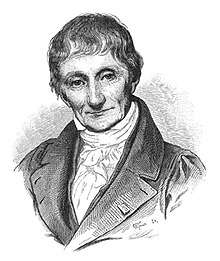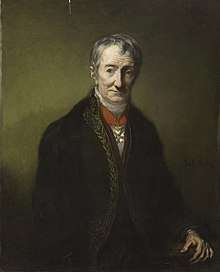Alexandre Brongniart
| Alexandre Brongniart | |
|---|---|
 Alexandre Brongniart | |
| Born |
5 February 1770 Paris, France |
| Died |
7 October 1847 (aged 77) Paris, France |
| Nationality | French |
| Scientific career | |
| Fields | |
| Institutions |
Sèvres - Cité de la céramique Manufacture nationale de Sèvres Royal Swedish Academy of Sciences |

Alexandre Brongniart (5 February 1770 – 7 October 1847) was a French chemist, mineralogist, and zoologist, who collaborated with Georges Cuvier on a study of the geology of the region around Paris.
Life
He was born in Paris, the son of the architect Alexandre-Théodore Brongniart and father of the botanist Adolphe-Théodore Brongniart.
He was an instructor at the École de Mines (Mining School) in Paris and appointed in 1800 by Napoleon's minister of the interior Lucien Bonaparte director of the revitalized porcelain manufactory at Sèvres, holding this role until death. The young man took to the position a combination of his training as a scientist— especially as a mining engineer relevant to the chemistry of ceramics— his managerial talents and financial acumen and his cultivated understanding of neoclassical esthetic.[1] He remained in charge of Sèvres, through regime changes, for 47 years.
Brongniart introduced a new classification of reptiles and wrote several treatises on mineralogy and the ceramic arts. He also made an extensive study of trilobites and made pioneering contributions to stratigraphy by developing fossil markers for dating strata.
Brongniart was also the founder of the Musée national de Céramique-Sèvres (National Museum of Ceramics), having been director of the Sèvres Porcelain Factory from 1800 to 1847. In 1823, he was elected a foreign member of the Royal Swedish Academy of Sciences.
Publications
- Traite Elementaire de Mineralogie (1807)
Family
His son was Adolphe Theodore Brongniart.
His daughter Herminie married Jean Baptiste Andre Dumas.[2]
Bibliography
- Alexexandre Brongniart: Essai d'une classification naturelle des reptiles. In: Magasin encyclopédique, ou journal des sciences, des lettres et des arts; rédigé par A. L. Millin. V. année. Tome sixième. Paris, an VIII [year 8 (of the Republic)] – 1799, p. 184–201 (HathiTrust).
- Brongniart, A. 1800. Essai d'une classification naturelle des reptiles. Bull. Soc. Philomath. 2 (36): 89-91.
- Alexandre Brongniart: Essai d'une classification naturelle des reptiles. In: Mémoires présentés a l'Institut des Sciences, lettres et arts, par divers savans, et lus dans ses assemblées. Sciences mathématiques et physiques. Tome premier. Paris, frimaire an XIV [frimaire year 14 (of the Republic)] = 1805, p. 587–637 (HathiTrust).
- Brongniart, Alexandre (January 1854). Traité des arts céramiques, ou des poteries considérées dans leur histoire, leur pratique et leur théorie (2nd ed.). Paris: Béchet jeune.
References
- Rudwick, Martin J.S., Georges Cuvier, Fossil Bones, and Geological Catastrophes. Chicago: The University of Chicago Press, 1997. ISBN 0-226-73106-5
This article incorporates text from a publication now in the public domain: Wood, James, ed. (1907). "article name needed". The Nuttall Encyclopædia. London and New York: Frederick Warne.
| Wikisource has the text of the 1911 Encyclopædia Britannica article Brongniart, Alexandre. |